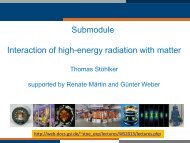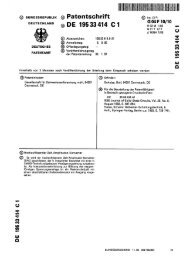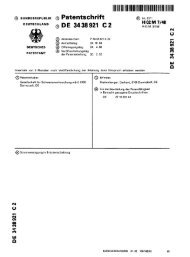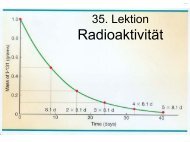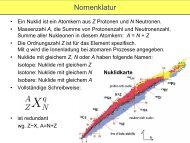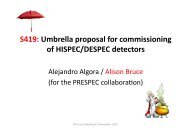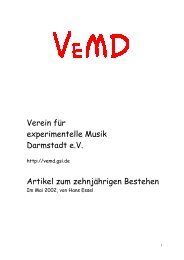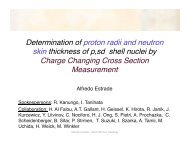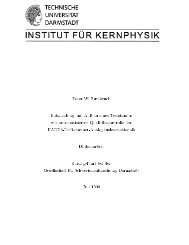doctoral thesis
doctoral thesis
doctoral thesis
You also want an ePaper? Increase the reach of your titles
YUMPU automatically turns print PDFs into web optimized ePapers that Google loves.
22 CHAPTER 1. INTRODUCTION<br />
1.3.4 Resistive Plate Chambers<br />
The Resistive Plate Chamber (RPC) was developed in 1981 by R. Santonico and R.<br />
Cardarelli [36, 37]. As the spark counter and the PPAC, the RPC consists of two<br />
parallel plate electrodes. At least one of the electrodes is made of a material with high<br />
volume resistivity. A charge Q0 that enters the resistive electrode surface ’decomposes’<br />
with time t following an exponential<br />
Q(t) = Q0 e −t/τ with τ = ρε0εr , (1.21)<br />
where ρ is the volume resistivity of the material, ε0 is the dielectric constant and εr<br />
is the relative permittivity of the resistive material. The volume resistivity is connected<br />
to the conductivity σ by ρ = 1/σ [Ωcm]. Typical glass resistive plates have a volume<br />
resistivity of ρ ≈ 10 12 Ωcm, leading to a ’relaxation time’ τ ≈ 1 s. The volume<br />
resistivity of Bakelite is of the order ρ ≈ 10 10 Ωcm, which gives a ’relaxation time’<br />
τ ≈ 10 ms. The charges in the resistive electrodes cause the high voltage and thus the<br />
electric field in the gas gap to drop locally around the initial avalanche or discharge.<br />
Here the detector has a blind spot for a time of the order of the relaxation time τ, but<br />
the remaining counter area is still sensitive to particles.<br />
Fig. 1.5 shows a schematic image of an example configuration of an RPC [36].<br />
The gas gap is sandwiched between the two resistive electrode plates. These plates<br />
are painted with a graphite coating of surface resistivity 200 to 300 kΩ/, which is<br />
used to distribute the high voltage on the electrodes. The shown configuration utilizes<br />
read out strips running along the whole length of the chamber on both sides of the gap,<br />
but perpendicular, allowing read out of the x- and y-coordinate of the position of a<br />
traversing particle. The strips are separated from the graphite coating by an insulating<br />
layer.<br />
RPCs may be operated in avalanche mode or in streamer mode (discharge mode).<br />
In avalanche mode the release of the primary charge by the incoming ionizing radiation<br />
is followed by the propagation and multiplication of the electrons corresponding to a<br />
Townsend avalanche. This is shown schematically in Fig. 1.6. At a large gas gain a<br />
change occurs in the avalanche dynamics: Then the avalanche charge carriers influence<br />
the electric field in the gas gap and hence their own propagation and multiplication (the<br />
space charge effect). If the gas gain is further increased, photons can start to contribute<br />
to the propagation of the avalanche and streamers appear [38, 39, 40]. At a later stage, a<br />
conductive channel can be formed between the two electrodes, through which the local<br />
electrode surfaces are discharged. A weak spark may be created. While in avalanche<br />
mode RPCs streamers are an unwanted side effect, streamer mode RPCs make use of<br />
the large current pulses induced by the streamers which simplifies the read out of the<br />
device. Fig. 1.7 shows schematic images of the streamer development in the gas gap.



